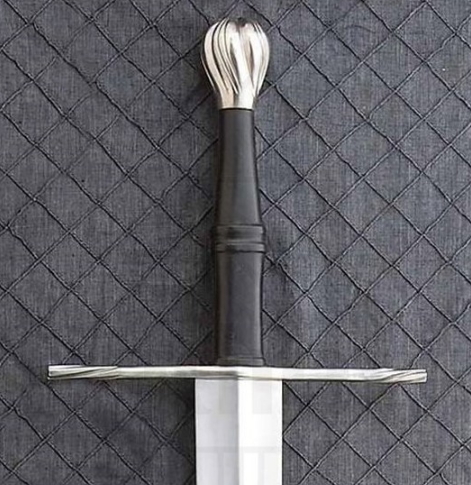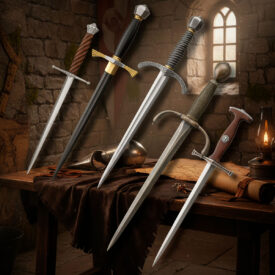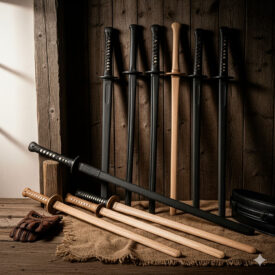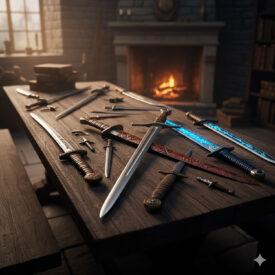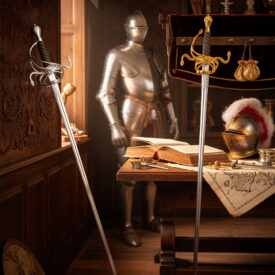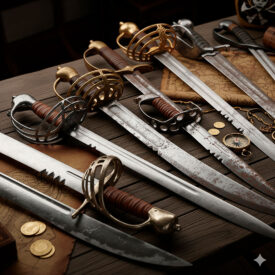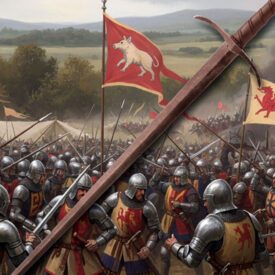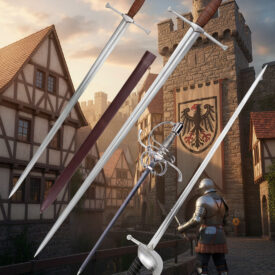What makes a sword capable of telling the story of a kingdom? The Schloss Erbach Sword answers with the voice of steel: a broad blade, a twisted pommel, and a balance designed for combat in the transition between the Middle Ages and the Renaissance. In this article, you will discover its origin, its anatomy, how its signs of use are interpreted, and how modern replicas seek to recreate its soul. I will guide you from the technical details to the cultural influence of this emblematic piece, and you will see comparisons, tables, and a clear chronology that places its journey through the centuries.

Brief History and Why It Matters
Born in the last quarter of the 15th century, the Schloss Erbach Sword is a witness to the evolution of European warfare and armor. It bore the imprint of its time: improved protections and the need for a versatile tool, capable of both cutting and thrusting. This sword is exceptionally well preserved and has been studied by experts such as Ewart Oakeshott, who classified it as an Oakeshott type XVIIIa but with an unusual width that distinguishes it from other examples of the same group.
History and Trajectory of the Schloss Erbach Sword
| Era | Event |
|---|---|
| Late 15th century (around 1480) | The Schloss Erbach Sword, a German longsword, dates from this period. It is classified as Oakeshott type XVIII A, an example of a medieval and Renaissance cut-and-thrust sword. |
| Mid-19th century to the interwar period | It probably left the armory of Erbach Palace and was sold to the private market, a common practice for feudal properties that needed to liquidate collections for their upkeep. |
| Second half of the 20th century | The sword was collected by the renowned expert Ewart Oakeshott. It was in excellent condition. |
| Spring 2019 | Dr. Nathan Clough, Vice President of Arms and Armor and a member of the Oakeshott Institute, brought the original Schloss Erbach sword to the HEMA Longpoint tournament in Maryland, where it was examined alongside a replica from Arms and Armor and a copy from a third party. |
| Contemporary period (around or after 2019) | Dale Utt III, an Oakeshott Institute researcher, developed a detailed 3D model of the original sword, using a proprietary method for shiny and hard-to-photograph objects. |
The Context: Schloss Erbach and Collection Preservation
Schloss Erbach, in Germany’s Odenwald region, housed a rich collection of weapons and artifacts. Like many European noble houses, the family of the Counts of Erbach maintained an arsenal that, over time, suffered partial dispersion into the private market between the 19th century and the decades of the 20th century due to economic pressures. Even so, pieces like the sword we are discussing have survived to this day in a state of preservation that allows for detailed study, both historical and technical.
Reading the Sword: What its Forms Say
A historical sword not only speaks through its marks of use but also through its silhouette. The Schloss Erbach presents features that reveal it as a versatile weapon:
- Relatively wide blade: Oakeshott observed it as somewhat wider than usual in XVIIIa, which increases the cutting surface without sacrificing thrusting capability.
- Entallada grip and writhen pommel: Allow for a firm grip and fine control in transitions between cuts and thrusts.
- Marked quillons: Protect the hand and offer points of support for advanced disarming techniques or opponent control.
Balance and Tactical Use
The sword’s balance indicates that it was designed for combat where cutting and thrusting alternated. Its high-carbon steel blade, slightly hollow, reduces weight in the center and provides inertia that favors powerful strikes without losing maneuverability. This makes it suitable for combat with one or two hands.
Technical Characteristics and Comparative Sheet
Below is a table with the most relevant measurements and specifications, integrated with data observed from the known specimen and modern replicas faithful to it.
| Attribute | Schloss Erbach Sword (original) | Typical Modern Replica (Windlass / Arms & Armor) |
|---|---|---|
| Weight | Approx. 1,360 g | 1,300–1,600 g (depending on adjustment) |
| Overall Length | ≈ 109 cm | ≈ 107–112 cm |
| Blade Length | ≈ 86 cm | ≈ 84–88 cm |
| Blade Width (at the guard) | ≈ 5 cm | ≈ 4.5–5.5 cm |
| Blade Material | Carbon steel (originals vary) | 1055 carbon steel or modern steel options (variable) |
| Thickness | Variable; known specimen has hollow areas | ≈ 4.5–5 mm in the section near the guard |
| Oakeshott Type | XVIIIa (no notable fuller) | XVIIIa (replicas faithful to the pattern) |
The Forging of a Replica: Technique and Historical Ethics
Recreating the Schloss Erbach requires more than copying measurements: it requires understanding texture, asymmetries, and signs of use. Companies with direct access to the original, such as Arms and Armor in collaboration with the Oakeshott Institute, have achieved superior replicas using techniques such as lost-wax casting for decorative parts and meticulous work in polishing and finishing.
The ethical debate among manufacturers revolves around two axes:
- Physical fidelity: reproduce imperfections and asymmetries so that the replica feels and looks like the original.
- Safe functionality: adapt tolerances and heat treatments for modern practices like HEMA, where steel and tempering influence safety.
Demonstrations and Comparative Studies
An illustrative example occurred in 2019 during the Longpoint tournament (Maryland), where Dr. Nathan Clough presented the original alongside replicas. Attendees could visually and tactilely compare the differences: in finish, fit, and dynamic sensations, the Arms and Armor replica stood out for its closeness to the original, especially in the pommel and cross made with traditional techniques.
How Experts Interpret Marks on the Blade
Specialists analyze wear, micro-pits, and curvatures to infer usage practices. In the Schloss Erbach, signs compatible with a used and maintained weapon are observed: small rectified nicks, traces of sharpening, and obvious care in the grip. These elements suggest both actual use and diligent subsequent preservation.
Common Indicators
- Nicks on the edge: caused by impact in combat, then rectified by smiths.
- Uniform patina: controlled oxidation indicating stable preservation, not abandonment.
- Asymmetries in pommel and guard: handmade pieces that show slight variations compared to completely symmetrical modern pieces.
Implications for Modern Practice (HEMA and Reenactment)
The Schloss Erbach is studied by practitioners of Historical European Martial Arts because its form suggests mixed techniques: wide cuts from the hip, short wrist cuts, and precise thrusts with point control. Understanding its balance helps configure replicas for training and learning.
- Weight adjustments: practitioners prefer slightly heavier or lighter variants depending on the focus (contact vs. technique).
- Grip: the original wood and leather define an ergonomics that many modern replicas try to imitate.
- Center of gravity: a slightly hollow blade shifts the balance towards the hand, favoring control over brute force.
Recommended Exercises based on the Sword
- Cut-thrust transition work: alternate a diagonal cut with a step and finish with a thrust from the same line.
- Disarms with quillons: practice grips and levers that use the cross to deflect and neutralize the opponent’s weapon.
- Point control exercises: short entries to improve precision in thrusts to the torso or sides of the simulated opponent.
Visual and Mechanical Comparison: Original vs. Replicas
To clarify differences and help those studying historical replicas, this table summarizes aspects detectable at a glance and in handling.
| Aspect | Original (Schloss Erbach) | Faithful Replica (Arms & Armor / Windlass) |
|---|---|---|
| Finish | Historical patina, signs of preservation and ancient repairs | Controlled polishing, simulated aging if requested |
| Asymmetries | Present in pommel and guard due to manual manufacturing | Attempt to reproduce, some less pronounced marks |
| Feel in hand | Centered balance, ‘lively’ feel in cuts | Similar if profile and temper are respected |
| Safety for HEMA | Not designed for modern sparring | Hardened variants/controlled temper and options with sharpened edges for safe practices |
The Sword as a Symbol: Status, Honor, and Representation
In late medieval Europe, the sword transcended its military use. It was a social emblem, present in investitures, portraits, and the daily attire of the nobility. The Schloss Erbach, due to its decorative and functional quality, fits this tradition: an object that communicates authority and martial skill.
Detailed TECHNICAL SPECIFICATIONS
| Element | Description |
|---|---|
| Manufacturer (indicated replica) | WINDLASS STEEL CRAFTS (examples of functional replicas) |
| Overall Length | 109 cm (approx. in replica based on original) |
| Blade Length | 86 cm |
| Weight | 1360 gr. |
| Blade Width (at the guard) | 5 cm |
| Blade Material | 1055 Carbon steel (typical replica) |
| Thickness | ≈ 4.7 mm near the guard (depending on replica) |
| Accessories | Includes scabbard in some functional replicas |
Maintenance and Conservation for Historical Pieces and Replicas
A piece of this caliber needs a regular conservation program. For originals and quality replicas, recommended practices include gentle cleaning, humidity control, periodic oiling, and storage in stable environments. For functional replicas used in practice, it is also crucial to frequently check grips, rivets, and the condition of the edge to ensure safety.
- Cleaning: dry cloth or slightly oiled to prevent corrosion.
- Humidity control: avoid humid chambers and sudden temperature changes.
- Storage: sheaths and supports that do not retain moisture; avoid prolonged contact with damp leather.
Questions Often Raised by the Schloss Erbach
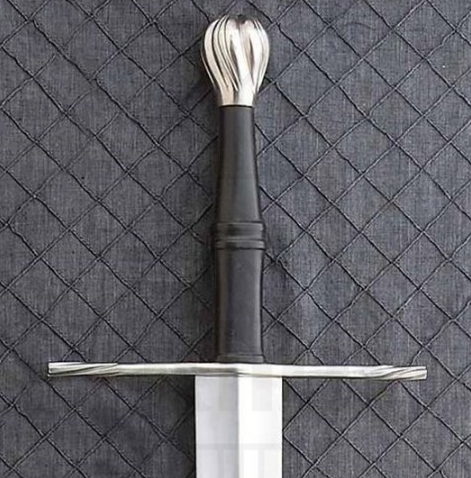
Among historians and reenactors, frequent questions arise such as: what fencing techniques best fit this profile? To what extent does a replica capture the experience of the original? How to distinguish original from copy? The answers lie in the combination of technical study (dimensions, metal microanalysis), visual comparison, and, when possible, physical access to the artifact for direct measurements.
Historical Value and Legacy Among Collectors
The value of the Schloss Erbach is not just monetary: it lies in its ability to teach us about combat methods and manufacturing from the late 15th century. Such pieces inspired modern master armorers and continue to guide reproduction practices, academic study, and pedagogy in HEMA.
Final Reflection
The Schloss Erbach Sword is, in essence, the convergence of art, technique, and symbolism. Studying it allows us to understand how form follows function, how the artisan’s hand imprints character onto metal, and how an object can transcend its use to become a living memory of an era. Whoever observes its curves and wields its form in imagination understands why some swords speak more than documents: because they bear the imprinted decisions of combat, aesthetic preferences, and the history of those who held them in their hands.
